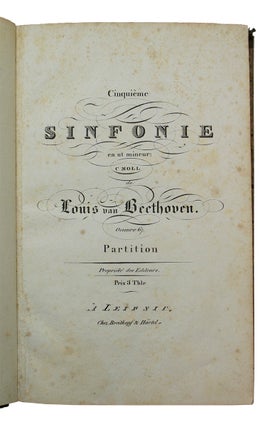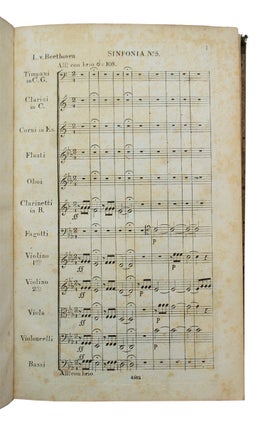First Edition of Beethoven's Fifth Symphony BEETHOVEN, Ludwig van, [composer]. Cinquieme sinfonie en ut mineur: C moll. Oeuvre 67. Partition Propriete des Editeurs. Prix 3 Thlr. Leipzig: Breitkopf & Haertel, 1826. Full Description:
Cinquieme sinfonie en ut mineur: C moll. Oeuvre 67. Partition Propriete des Editeurs. Prix 3 Thlr.
Leipzig: Breitkopf & Haertel, 1826.
. Cinquieme sinfonie en ut mineur: C moll. Oeuvre 67. Partition Propriete des Editeurs. Prix 3 Thlr. Leipzig: Breitkopf & Haertel, 1826.
First edition of the complete score of Beethoven's remarkable Fifth Symphony. Quarto (9 7/8 x 6 3/8 inches; 250 x 163 mm.). [2], 182, [2, blank] pp. Every page fully engraved includeing an engraved title-page, and with plate marks very visible. Each plate besides the title with number 4302 engraved at the bottom.
Contemporary half green cloth over marbled boards (in an eyeball pattern). Tan spine label, lettered in gilt. Spine stamped in gilt. All edges speckled red. Boards with some toning and chipping of paper to edges. Corners bumped. Spine with a coating to the cloth, a bit browned. Head and tail of the spine with some rubbing to cloth. Spine label is chipped along edges. A bit of toning and minor foxing to some leaves, but overall a very good copy of this very scarce item.
"On December 22, 1808, Viennese devotees of new music made their way to the Theater-an-der-Wien for the most significant concert of the year, one of the most significant concerts in all of music history. The program, consisting entirely of Beethoven premieres, began with the Symphony no. 6, followed, in order, by the concert aria, "Ah, perfido", two movements from the Mass in C major, the Fourth Piano Concerto, the Symphony no. 5, and, last but not least, the Choral Fantasy. It was four hours of music, new music to their ears. The theater was unheated, the orchestra was under-rehearsed, and the soprano soloist had a bad case of stage-fright. The whole experience led one listener to comment later that "one can have too much of a good thing --- and still more of a loud".
Those pieces all premiered together because Beethoven habitually worked on several compositions simultaneously. He began the work now known as the Fifth Symphony around 1804, just after finishing the Third Symphony. Many other projects intervened, however, including what became the Fourth Symphony, pushing this one a bit further down the list. In fact, it nearly moved down even more. Beethoven completed this c minor symphony at nearly the same time he finished the F major Symphony, the Pastorale, and, at that first concert, it was the Pastorale that bore the number five. Somewhere between performance and publication, Beethoven renumbered the two. The c minor became the Fifth, and the F major became the Sixth, as they are known today.
Music critics had little to say about the Fifth at its premiere. However, a year and a half later, the Allgemeine musicalische Zeitung gave a highly favorable review of another performance. The reviewer described the work this way: "Radiant beams shoot through the deep night of this region, and we become aware of gigantic shadows which, rocking back and forth, close in on us and destroy all within us except the pain of endless longing --- a longing in which every pleasure that rose up amid jubilant tones sinks and succumbs. Only through this pain, which, while consuming but not destroying love, hope, and joy, tries to burst our breasts with a full- voiced general cry from all the passions, do we live on and are captivated beholders of the spirits". Few reviewers today write with such descriptive energy, perhaps because few reviewers are novelists and few are composers. E. T. A. Hoffmann, author of that particular review, was both.
The Fifth Symphony has undergone much analysis since Hoffmann's attempt, and those first four notes have drawn much of the attention. Beethoven himself allegedly described them as "Fate knocking at the door". It's an evocative image, but the source on that statement, Beethoven's sometime friend Anton Schindler, was known for not letting facts get in the way of a good story. Furthermore, the supposed conversation took place years after the symphony was finished, and Beethoven had been known to say nearly anything to relieve himself of questioning pests, such as Schindler. Whether or not there is a symbolic meaning to the notes, their musical meaning is clear: G and E-flat are two of the three notes that comprise a c minor chord. Thus, with this opening motif, Beethoven bellows at his listeners the key of his symphony, then hammers the point home by repeating the rhythm throughout the work. Sometimes ominous, sometimes triumphant, the four-note pattern remains the recurring element that unites the symphony's four movements" (Elizabeth Schwarm Glesner). it was not available in printed form until this publication of 1826. The last copy to come up at auction was in 1983.
HBS 68882.
$15,000.
Price: $15,000.00
Item #68882



